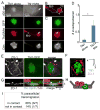Macrophage contact induces RhoA GTPase signaling to trigger tumor cell intravasation
- PMID: 24056963
- PMCID: PMC3962803
- DOI: 10.1038/onc.2013.377
Macrophage contact induces RhoA GTPase signaling to trigger tumor cell intravasation
Abstract
Most cancer patients die as a result of metastasis, thus it is important to understand the molecular mechanisms of dissemination, including intra- and extravasation. Although the mechanisms of extravasation have been vastly studied in vitro and in vivo, the process of intravasation is still unclear. Furthermore, how cells in the tumor microenvironment facilitate tumor cell intravasation is still unknown. Using high-resolution imaging, we found that macrophages enhance tumor cell intravasation upon physical contact. Macrophage and tumor cell contact induce RhoA activity in tumor cells, triggering the formation of actin-rich degradative protrusions called invadopodia, enabling tumor cells to degrade and break through matrix barriers during tumor cell transendothelial migration. Interestingly, we show that macrophage-induced invadopodium formation and tumor cell intravasation also occur in patient-derived tumor cells and in vivo models, revealing a conserved mechanism of tumor cell intravasation. Our results illustrate a novel heterotypic cell contact-mediated signaling role for RhoA, as well as yield mechanistic insight into the ability of cells within the tumor microenvironment to facilitate steps of the metastatic cascade.
Conflict of interest statement
The authors have no conflicts of interests to declare.
Figures







Similar articles
-
Macrophage-dependent tumor cell transendothelial migration is mediated by Notch1/MenaINV-initiated invadopodium formation.Sci Rep. 2016 Nov 30;6:37874. doi: 10.1038/srep37874. Sci Rep. 2016. PMID: 27901093 Free PMC article.
-
Invasive breast carcinoma cells from patients exhibit MenaINV- and macrophage-dependent transendothelial migration.Sci Signal. 2014 Nov 25;7(353):ra112. doi: 10.1126/scisignal.2005329. Sci Signal. 2014. PMID: 25429076 Free PMC article.
-
A novel neuregulin - jagged1 paracrine loop in breast cancer transendothelial migration.Breast Cancer Res. 2018 Apr 10;20(1):24. doi: 10.1186/s13058-018-0960-8. Breast Cancer Res. 2018. PMID: 29636067 Free PMC article.
-
Intravasation as a Key Step in Cancer Metastasis.Biochemistry (Mosc). 2019 Jul;84(7):762-772. doi: 10.1134/S0006297919070071. Biochemistry (Mosc). 2019. PMID: 31509727 Review.
-
Spatial regulation of tumor cell protrusions by RhoC.Cell Adh Migr. 2014;8(3):263-7. doi: 10.4161/cam.28405. Cell Adh Migr. 2014. PMID: 24642482 Free PMC article. Review.
Cited by
-
RHOA mutation in diffuse-type gastric cancer: a comparative clinicopathology analysis of 87 cases.Gastric Cancer. 2016 Apr;19(2):403-411. doi: 10.1007/s10120-015-0493-0. Epub 2015 Apr 1. Gastric Cancer. 2016. PMID: 25823974 Free PMC article.
-
The Influence of VE-Cadherin on Adhesion and Incorporation of Breast Cancer Cells into Vascular Endothelium.Int J Mol Sci. 2021 Jun 3;22(11):6049. doi: 10.3390/ijms22116049. Int J Mol Sci. 2021. PMID: 34205118 Free PMC article.
-
Applying nanomedicine in maladaptive inflammation and angiogenesis.Adv Drug Deliv Rev. 2017 Sep 15;119:143-158. doi: 10.1016/j.addr.2017.05.009. Epub 2017 May 12. Adv Drug Deliv Rev. 2017. PMID: 28506745 Free PMC article. Review.
-
Endothelin A receptor drives invadopodia function and cell motility through the β-arrestin/PDZ-RhoGEF pathway in ovarian carcinoma.Oncogene. 2016 Jun 30;35(26):3432-42. doi: 10.1038/onc.2015.403. Epub 2015 Nov 2. Oncogene. 2016. PMID: 26522724
-
Macrophage-dependent tumor cell transendothelial migration is mediated by Notch1/MenaINV-initiated invadopodium formation.Sci Rep. 2016 Nov 30;6:37874. doi: 10.1038/srep37874. Sci Rep. 2016. PMID: 27901093 Free PMC article.
References
-
- Wyckoff J, Wang W, Lin EY, Wang Y, Pixley F, Stanley ER, et al. A paracrine loop between tumor cells and macrophages is required for tumor cell migration in mammary tumors. Cancer research. 2004;64(19):7022–9. Epub 2004/10/07. - PubMed
-
- Wyckoff JB, Wang Y, Lin EY, Li JF, Goswami S, Stanley ER, et al. Direct visualization of macrophage-assisted tumor cell intravasation in mammary tumors. Cancer research. 2007;67(6):2649–56. Epub 2007/03/17. - PubMed
-
- Zervantonakis IK, Hughes-Alford SK, Charest JL, Condeelis JS, Gertler FB, Kamm RD. Three-dimensional microfluidic model for tumor cell intravasation and endothelial barrier function. Proceedings of the National Academy of Sciences of the United States of America. 2012;109(34):13515–20. Epub 2012/08/08. - PMC - PubMed
-
- Robinson BD, Sica GL, Liu YF, Rohan TE, Gertler FB, Condeelis JS, et al. Tumor microenvironment of metastasis in human breast carcinoma: a potential prognostic marker linked to hematogenous dissemination. Clinical cancer research : an official journal of the American Association for Cancer Research. 2009;15(7):2433–41. Epub 2009/03/26. - PMC - PubMed
Publication types
MeSH terms
Substances
Grants and funding
LinkOut - more resources
Full Text Sources
Other Literature Sources

